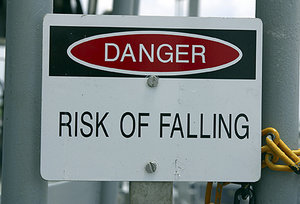Neck pain can be acute (short term) or chronic (recurring or
persisting for months and even years), but regardless, when you're in
pain, relief is the first thing on your mind. Just as important as
relief, of course, is finding the cause and ensuring you avoid the
behavior / action that brought the pain on in the first place. Here are
five common causes of neck pain – and why doctors of chiropractic are
well-suited to relieve the pain
and determine the underlying cause.
1. Poor Posture: Leaning over a desk all day or slouching in
your office chair? You're bound to develop neck pain eventually, if you
haven't already. Do this quick test: In an upright or seated position,
round your shoulders and back (poor posture). Does it impact your neck
as well? Exactly!
2. Monitor Madness: Staring at the computer screen for hours
at a time? That's not good for your health (or sanity), but from a neck
pain perspective, it's madness, particularly if the
screen height forces you to crane your neck up (too high) or extend it down (too low).
3. Sleep Issues: Ideally, we spend a third of our day
sleeping, so your sleep habits – for better or worse – can have a
dramatic effect on your health. With regard to neck pain, anytime you
sleep in an uncomfortable position, particularly one that stresses your
neck musculature (think about side-sleeping while grabbing your pillow
tightly, sleeping on your stomach with your arms out in front of you, or
even sleeping on your back, but with a pillow that doesn't adequately
support your neck), you risk neck pain.
 4. Technology Overload
4. Technology Overload: We may spend a third of our day
sleeping, but we increasingly spend the other 16 hours typing, texting,
tapping and otherwise interacting with our smartphones, tablets, etc.
Bottom line: bad for your neck. One doctor has even coined the phrase,
"text neck," to describe the neck pain that can result from this constant technology interaction.
5. The Wrong Movement: Twisting, turning, stretching and
stressing your neck is an easy way to cause neck pain. While the muscles
in the neck are strong, they can be strained, sprained and even torn,
just like any other muscle.
It's important to note that beyond these common causes, various other
health issues can also contribute to or directly cause neck pain,
including
fibromyalgia,
cervical arthritis or spondylosis (essentially spinal arthritis),
spinal stenosis (narrowing of the spinal canal), infection of the spine,
and even cancer. The good news is that a doctor of chiropractic can
help identify which of these or the above causes is to blame.
When neck pain strikes, most people turn to a temporary solution
first: pain-relieving medication. But that's not a permanent solution,
of course, and it doesn't address the cause of the pain at all, which
could be something relatively minor – or more serious. What's more,
research suggests chiropractic spinal manipulation is actually
more effective than over-the-counter
and prescription medication for relieving both acute and subacute neck pain.
Suffering from neck pain? Then give your doctor of chiropractic a call. They'll help you relieve your pain
and determine the cause so it doesn't return.
 Yes, research suggests people who exercise are less likely to develop
low back pain – 33 percent likely, according to a review of 16
previously published studies published in the American Journal of Epidemiology.
Exercises that strengthen and stretch the lumbar (low back) and
abdominal muscles, or strengthening and aerobic exercises combined, seem
to do the trick, according to the lead study author. And it gets
better: Back pain severity and resulting disability were also lower in
patients who exercised.
Yes, research suggests people who exercise are less likely to develop
low back pain – 33 percent likely, according to a review of 16
previously published studies published in the American Journal of Epidemiology.
Exercises that strengthen and stretch the lumbar (low back) and
abdominal muscles, or strengthening and aerobic exercises combined, seem
to do the trick, according to the lead study author. And it gets
better: Back pain severity and resulting disability were also lower in
patients who exercised.






